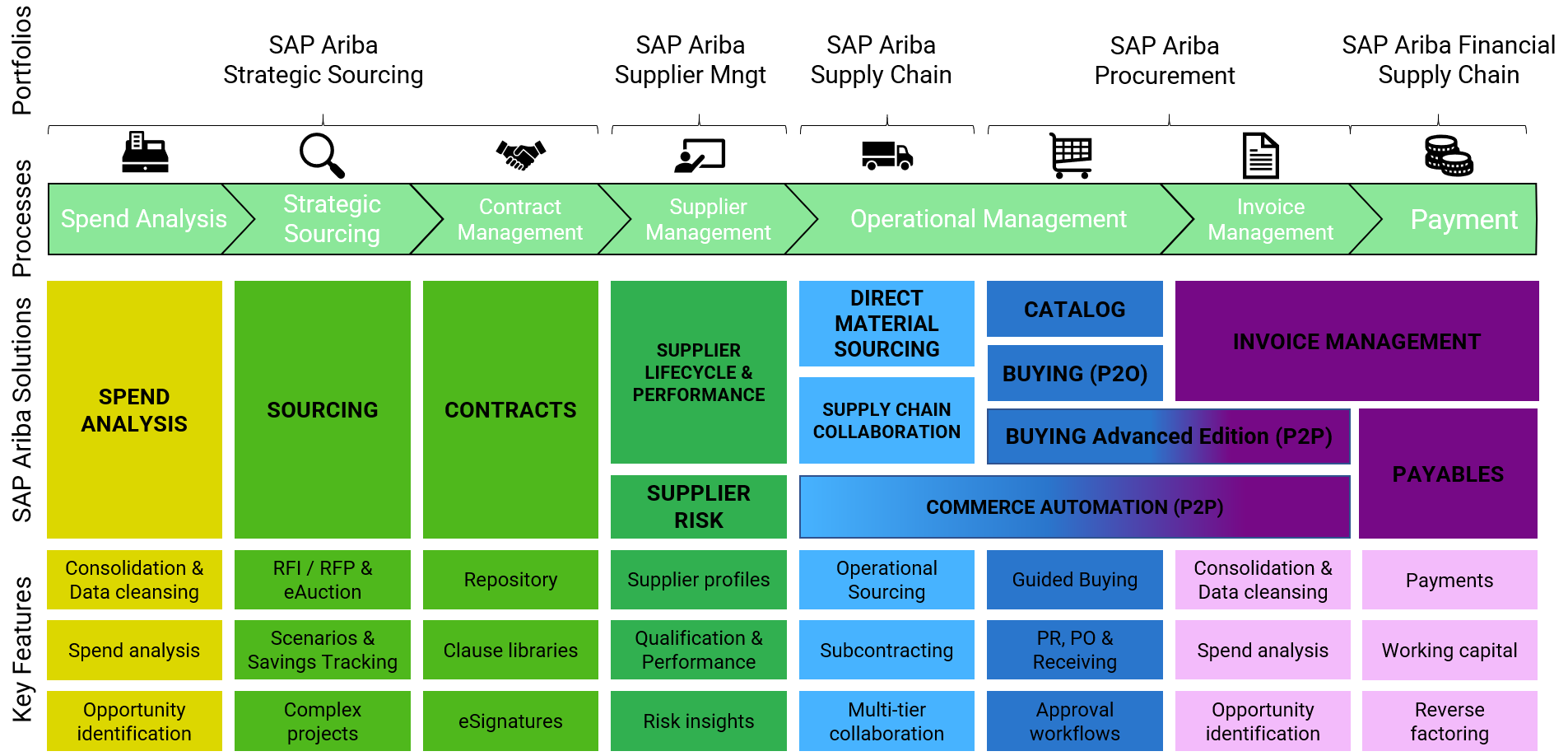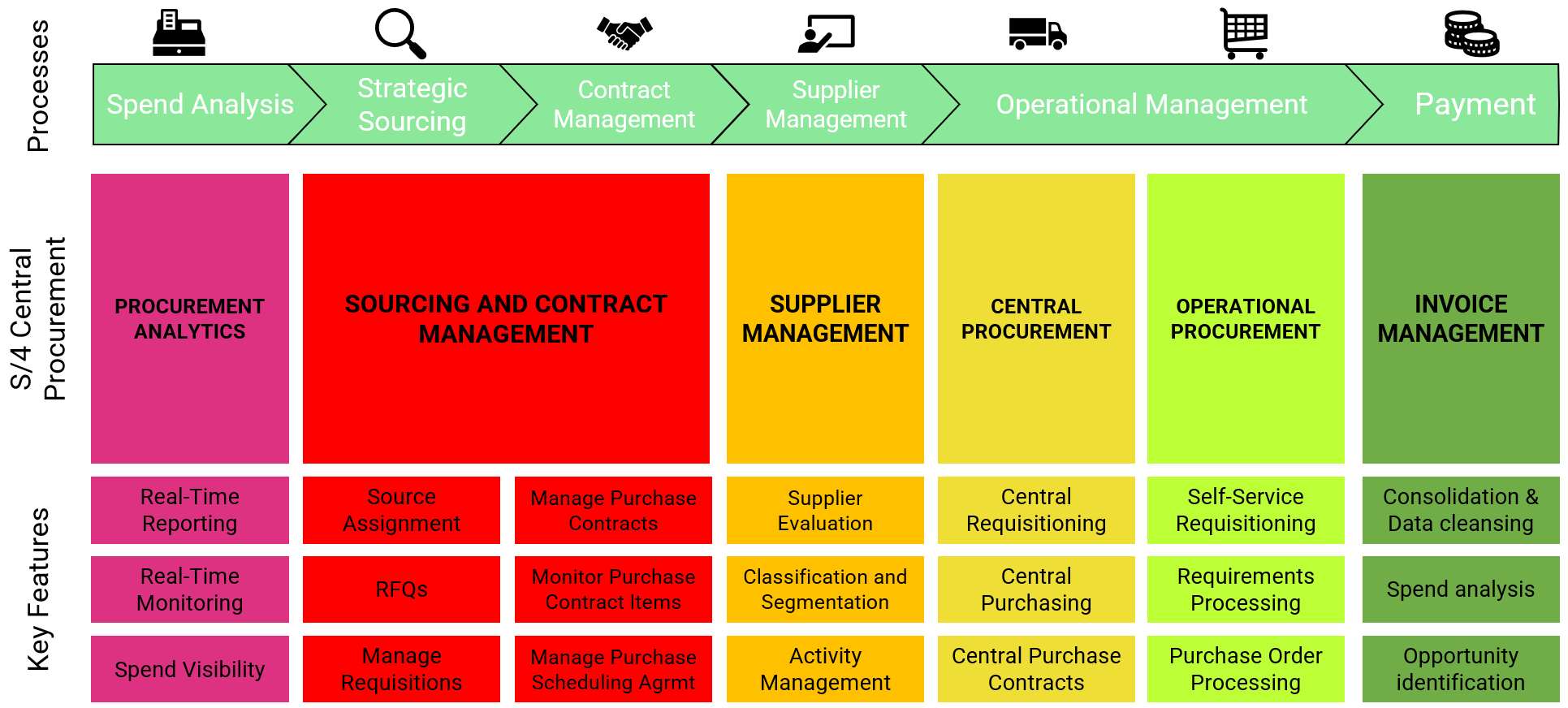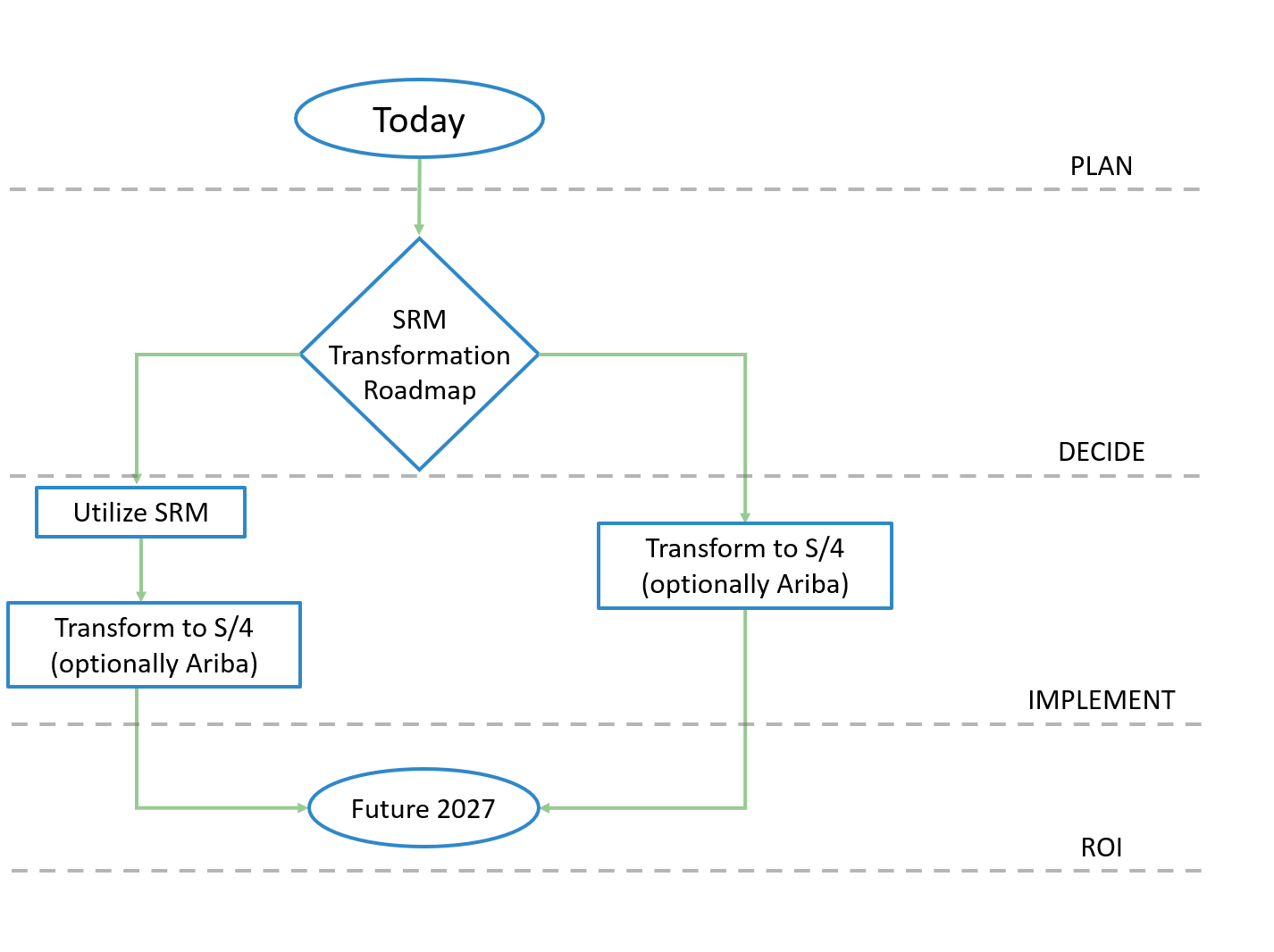Learn how we develop the ideal roadmap considering the diversity of specifications of each company.
Management Summary
For businesses which currently use SAP software to cover their procurement processes, a transformation towards the new S/4HANA and/or SAP Ariba seems inevitable. While SAP S/4HANA and SAP Ariba are said to have significant potential to increase procurement efficiency and cost effectiveness, the transformation towards these tools outlines a massive challenge for many businesses. The pure volume of information or the variety of buzzwords linked to this transformation increase the confusion for some businesses utilizing SRM, on how to best handle this situation.
One should consider the current ERP landscape as this has a significant impact on what tool should be adopted. For instance, a business which connects their systems to one ERP only, does not require the full data centralization capabilities which come with some of the newly offered tools.
Another factor to consider is whether the transformation is technical or process driven. In case of a pure technical transformation in which the procurement tool (SRM) remains the same, it is completely legitimate to keep the SRM and connect it to the new ERP (here: S/4HANA) landscape.
Finally, to identify the right procurement tool the current process requirements have to be mapped. This enables the identification of the ideal tool. While SAP Ariba covers most of the supplier (external) facing processes, the S/4 Central Procurement Hub maps the in-house (internal) procurement processes.
As all businesses are individual and have different requirements, the following outlines how to approach the procurement transformation in more detail. The goal is to create a picture on how to identify the ideal roadmap considering the variety of specifications which are relevant to the individual business.
Current System Landscape
The current system landscape has significant impact on what tool is suitable for the future. One key idea behind S/4 Central Procurement Hub and SAP Ariba is that they serve as a centralized system connected to multiple ERP systems. Not all businesses own a multiple ERP system landscape which impacts the SRM transformation.
1. The current SRM is connected to a single ERP
As outlined, the new SAP procurement tools serve as systems which centralize the data from multiple connected ERPs back-ends. A business which only utilizes a single ERP would therefore not require a centralization scenario as the data derives from a single source only. In this case only a transformation towards the S/4 Procurement Core is required, while additional process features of Ariba can be adopted. It is possible to continue utilizing the current SRM system and deploy it onto the new ERP system, bearing in mind that SAP users should switch by 2027 at the latest.
2. The current SRM is deployed on the same client as the ERP (“One-Client”)
Similar to single ERP system landscape, a centralization functionality is redundant if the SRM is deployed within the same client as the ERP. In this case a business may rather adopt the S/4 Procurement Core and include Ariba features accordingly. One should bear in mind, that if the current ERP is transformed to S/4, SRM must be de-installed to migrate. In this case it would not make sense to “reinstall” the SRM on a separate server. Instead one should rather adopt the new S/4 Procurement Core.
3. The current SRM is connected to multiple ERPs
If multiple ERPs are connected, the SAP S/4 Central Procurement Hub should be deployed. The hub system would enable the centralization of data from multiple ERPs which grants an improved integration of the various data sources. By adopting SAP Ariba in addition to the S/4 Central Procurement Hub, further procurement processes can be mapped depending on the customer’s individual requirements. It makes sense to take a closer look into the centralization of master data, especially for suppliers, during centralization projects. For instance, MDG solutions which support the data harmonization and perform the master data governance are not necessarily required from a technical perspective but may be beneficial.
IT OR BUSINESS DRIVEN TRANSFORMATION
Having roughly outlined the impact of the ERP model towards the SRM transformation, the next question is whether the transformation is technical, or procurement driven. Ideally both sides work together to achieve a common goal. However, this may not always be the case. If the project is a purely technical driven topic, as the ERP systems are transformed to the S/4HANA Database, the procurement side has the opportunity to keep those processes which are mapped within the SRM and connected to the new ERP. On the contrary, if the transformation is process driven, SAP Ariba and S/4 Central Procurement Hub can be connected to the “old” ERPs.
If a technical and process transformation is considered, businesses have a variety of options and a certain grade of flexibility. The new S/4HANA is deployed while the business side must consider what solutions should be adopted to map the end-to-end procurement process. Generally speaking, SAP Ariba covers the external procurement processes, meaning that this tool is responsible for the supplier integration. If a business only has little supplier interaction the S/4 Central Procurement Hub covers the internal procurement process. A hybrid scenario including the S/4 Central Procurement Hub and the individually required SAP Ariba tools is also possible.
Whatever the main driver of the transformation may be, business may want to utilize SAP Activate which is used in S/4 HANA. It includes three components to support the project:
- SAP Best Practices (Business Process Structure, migration documents, graphical representation documents, pre-defined test scripts, etc.)
- Guided Configuration including a set of tools supporting the implementation of S/4 HANA
- One Methodology which is used for initiating any implementation of SAP S/4HANA
TO-BE PROCESS LANDSCAPE
The following graph will display the available processes in SAP Ariba.

To determine what tools are required, businesses should analyse their current process landscape. After identifying the core process requirements, the To-Be process can be mapped in relation to the new SAP procurement tools.

To outline what this means for the arguably most adopted procurement processes, examples are outlined in the following.
The operative procurement including the P2P (Purchase-to-Pay) process is covered within the S/4 Central Procurement Hub. Based on the individual SAP customer’s requirements, further functionalities from SAP Ariba can be adopted. The outlined exception operative procurement in SAP Ariba is called “Guided Buying”. While Central Requisitioning (S/4) does the job, Guided Buying (Ariba) is probably the more advanced option to cover the P2P process.

For the strategic procurement we have a similar picture. In terms of Supplier Management, the basic functionalities and non-supplier facing side is mapped within S/4 Central Procurement Hub. While Ariba provides an opportunity to sourcing as well as supplier onboarding, S/4 procurement covers supplier evaluation.


It is the nature of Contract Management that suppliers and the procurement department of an organisation negotiate and agree on contract terms collaboratively. It is therefore not surprising, that SAP Ariba is the preferred tool, when it comes to implementing a full contracting lifecycle.

The Sourcing process can be mapped in different ways, depending on the relevance of strategic sourcing. Purchasers can request quotations through SAP S/4 Central Procurement Hub or adopt SAP Ariba Sourcing for more strategically supportive applications. A key potential of SAP Ariba Sourcing is the ability of supporting purchasers with reducing the sourcing cycle times as well as better competitive negotiating.


WHEN TO ACT
Having now shed some light on the future procurement processes and how the current system landscape affects the SRM transformation the rightful question is: How to proceed? First of all, the To-Be process should be defined while bearing in mind the system capabilities of S/4HANA and SAP Ariba as well as the current ERP model. While this To-Be process is mapped, businesses should also analyse their current in-house developments to identify whether they can be mapped within the new SAP tools. This could be done in the previously mentioned SAP Activate. It is important that in some cases in-house solutions can’t be connected to the new systems for various reasons while they increase the project complexity significantly. However, once the To-Be process is identified the transformation roadmap should be defined based on the process and system landscape requirements and the complexity concerning the in-house developments.
It is crucial to differentiate between planning and carrying out the transformation. It is a major change and requires in-depth preparation which is why businesses should not wait but initiate the planning stage straight away. However, it is completely legitimate to keep and optimize the SRM for now. This includes bringing automation into your existing landscape now instead of waiting until after the transformation. The actual transition for the procurement / SRM can then be conducted at a later point in time, when as businesses may want to wait until the S/4 and connected tools provide additional features. The bottom line is that planning should be started now, while carrying out the transition may be subject to the future.

ABOUT PARASUS
At parasus we have experience with providing our customers with the best possible results which the SAP standard offers in procurement. Our goal is to meet our customers’ individual requirements while creating a strategy and roadmap for the future. Our strength is to clearly outline the available options for our customers, while indicating the advantages and disadvantage of each. The SRM transformation is a major challenge both from a technical and process perspective, which is why it is important that businesses act and plan now to stay ahead of future bottlenecks.
Do you have questions about your upcoming (SRM to S/4) transformation or what the best (cost-efficient / value) approach would be for you? We’re here to help you with that so feel free to reach out at hello@parasus.com or visit us at parasus.com.
REFERENCES
SAP, SAP S/4HANA and SAP Ariba are the registered trademarks of SAP SE in Germany and in several other countries.
Copyright 2020 parasus GmbH. All rights reserved. All trademarks are the property of their respective owners.
Published on 13. October 2020
SAP SE (2020)
Design the future of your Supplier Relationship Management
www.sap-digital-business-services.comSAP SE (2020)
Transform Procurement with SAP Solutions.
Retrieved from